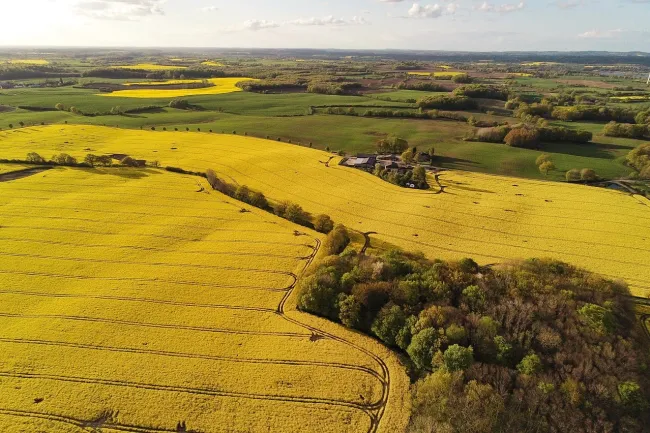This review article focuses on the practical implications for livestock farmers and their pastures of a shift towards a plant-based diet in the UK. The authors argue that the majority of pastures are unsuitable for conversion to arable land because of their soil type, making them unreliable sites for plant-based protein production.

Researchers of this article highlight that considerable evidence now exists about the harmful effects of livestock agriculture on the environment and that recommendations for a more sustainable diet (such as the EAT-Lancet report) focus on the need for a shift towards more plant-based diets due to their lower greenhouse gas, land-use and health impacts. This paper explores the impact of an increased demand for plant-based, cereal protein on UK farmers and agricultural land. The authors suggest that shifting towards a plant-based diet would require a conversion of grassland to arable land in the UK to meet the demands of a growing population. This is is contra to a current general consensus (see our Feed-Food Competition explainer, a report from Our World in Data and research by Poore and Nemecek, 2018)
The authors base their assumption on a referenced study (Van Kernebeek et al., 2016) which explored land use for plant-based diets in temperate countries under a scenario of self-sufficiency, excluding food imports or exports. The cited paper concludes that a diet with 12% animal-derived protein has the highest land use efficiency. This proposed diet uses up less land than a plant-based one if livestock are solely fed on waste products from food production and grazed on marginal land. The authors of this paper conclude, that under these specific assumptions, if a growing population would prefer a diet with less than 12% of their total protein intake to be derived from animal products, the available arable land would be insufficient. Note that the ‘optimal’ scenario identified by Van Kernebeek et al. (2016) nevertheless represents a substantial reduction in meat consumption in the UK as compared to the current situation. Also, the paper reviewed assumes a very austere diet and does not include any vegetable or fruit production in the calculations. Moreover, this study primarily considers cereals as the main source of plant-based protein rather than taking crop rotations with protein-rich legumes into account (Singh, 2017).
Note that the authors of this paper do not actually present any primary data or undertake any calculations. It is unclear if the authors of this paper are discussing the consequences of a reduction of meat consumption scenario or total veganism. They also do not specify the types of animal products being reduced in the scenario. They further do not take into account the impact of UK consumption patterns on agroecosystems overseas, especially overseas feed imports for the livestock industry. Despite these imports, 40% of the UK’s arable land is currently used for feed instead of food production and others have pointed out (WWF, 2022) that, in light of this, the need for ploughing up pastures. Note also that the Van Kernebeek study also takes a global perspective and is not UK specific. Moreover there has been more recent research that seeks to optimise land use which finds a role for some ruminant production in that they make use of land unsuitable for cropping but they find that production and consumption would be reduced to considerably lower levels than at present (van Zanten et al., 2018; van Zanten et al., 2023).
The paper builds their argument by first examining the history of land use in the UK and the development of modern pastures. They highlight multiple cases of land use changes in British history, often driven by technological advancements like drainage and artificial fertiliser. The paper argues that historically, pastures were intentionally established in areas unsuitable for arable farming. The key limitations in these regions were not weather-related but instead, centred around specific soil types and their proneness to waterlogging. This can be seen by comparing Figures 1 and 2. Converting these pastures to arable fields would likely result in low-quality cereals unsuitable for human consumption because of poor soil conditions impacting yields, plant health, and protein content.
Figure 1: Number of days in a year during which the soil in England and Wales surpassed its water holding capacity.
Figure 2: Landscape structure of the UK in 2015. The red dot represents the location of the author's research site.
The paper further argues that converting pastures to arable land could lead to a decline in soil organic matter. They note that pastures in temperate ecosystems typically store more carbon than arable land, as a result of minimal soil disturbance and continuous plant cover. However, they also note that this picture is complex and new research suggests that a shift to arable can result in a short-term increase in soil carbon with proper management. Such a shift to arable uses might also exacerbate soil erosion, contributing to sediment pollution in rivers and lakes. Additionally, they argue that a reduction in livestock farming could reduce the availability of organic fertiliser, further depleting soil organic matter and potentially increasing nitrous oxide emissions from artificial fertiliser use. However, they do not take the use of artificial fertiliser in arable feed production into account, lacking a consideration of nitrogen use efficiency. Moreover, the conversion of pastures may reduce countryside biodiversity, though outcomes depend on factors such as overall landscape heterogeneity, since different species thrive in different conditions. In addition, the paper underscores the lack of infrastructure in pasture-based regions such as mills or agricultural vehicles suitable for the wetter soil conditions.
The authors conclude with a plea for more pragmatic discussions regarding dietary change. Whilst the authors note support for a shift towards plant-based diets, acknowledging the environmental benefits, the paper stresses the need for robust evidence regarding their impact on land use.
References
Blackwell, M.S.A. et al. (2024) Potential unintended consequences of agricultural land use change driven by dietary transitions, Nature News.
Kernebeek, H.R.J.V. et al. (2015) Saving land to feed a growing population: Consequences for consumption of crop and livestock products, The International Journal of Life Cycle Assessment.
Singh, N. (2017) Pulses: An overview, Journal of food science and technology.
Van Zanten, H. H. E. et al. (2018) Defining a land boundary for sustainable livestock consumption. Global Change Biology
van Zanten, H. H. E. et al. (2018) Defining a land boundary for sustainable livestock consumption. Global Change Biology
van Zanten, H.H.E., Simon, W., van Selm, B., Wacker, J., Maindl, T.I., Frehner, A., Hijbeek, R., van Ittersum, M.K., Herrero, M., 2023. Circularity in Europe strengthens the sustainability of the global food system. Nat Food 4, 320–330.
WWF (2022) The Future of Feed, WWF-UK.
Read the full article here and listen to our Podcast episode on Plant-based - Planet friendly or unnatural?




Comments (0)